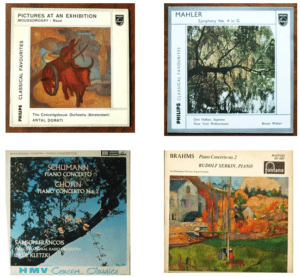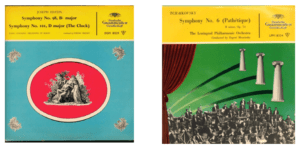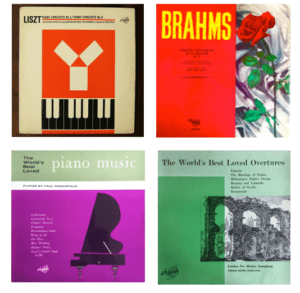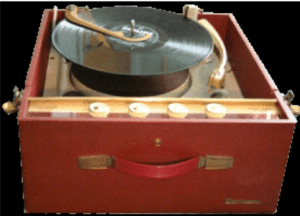My Little Gnudren,
The year is 1963. It is a bright Saturday morning and young Gnu and one of his older siblings are off to Bond Street Tube Station from Westbourne Park. (Since Father Gnu is an employee of London Transport they can travel anywhere on the Underground network for threepence.) They have accumulated two weeks pocket money – older brother gets 3 shillings and six pence (17½p) and younger Gnu gets a half-crown (12½p). So, they have 12 shillings (60p) at their disposal minus 6d (2½p) for their fare. They head for the HMV record shop on Oxford Street. There they look longingly through the racks of the cheapest LPs available. They mostly look like some of these:

These are budget labels, but the cheapest of these is 17/6d, way beyond their reach. After an hour, with aching hearts, they leave the shop empty-handed, but not before thumbing through racks of LPs that looked like this:

Young Gnu thought that these were LPs millionaires purchased because they cost £2 or more. The path of pilgrimage then took them along Oxford Street towards Marble Arch and Selfridges. There on the corner of the second floor was a stand of even cheaper LPs. Here you could buy a whole LP for 10 shillings (50p)! A new label, ARC Fidelity, was turning out performances of the standard repertoire, for only 10 shillings albeit by unknown artists and alas most of the record covers were in drab colours (except for the two pictured below.) So, they couldn’t be as good as the other desirables left behind at HMV. And what can you expect for 10 shillings? Beggars can’t be choosers. So slowly over the months of the early ’60s the highlight of their lives is to go to Oxford street and spend their accumulated wealth. The days of squandering pocket money on fleshly and carnal delights (eating chocolate and liquorice sticks) were well and truly over. Here are some the LPs that they purchased:

After acquiring their precious purchases, the Gnu siblings returned home to play their newly acquired treasures on one of these:

Imagine Gnu’s amazement when from these cheap LPs he heard astonishing performances of these works that outclassed a lot of what he heard on the BBC Radio Third Programme. As a precocious youngster he was able to attend some rehearsals of world class orchestras and virtuosi at the Royal Festival Hall, in short trousers. On one such occasion he and a violinist friend, Irvine, were at a rehearsal of Chopin Piano Concerto No.1 at the RFH with Malcolm Sargent and the pianist Emil Gilels and the LPO. The playing of Mr.Gilels, left an indelible mark on young Gnu. He wished he could own a recording by Emil Gilels, but in short trousers and two and six a week that was impossible. (Graduation to long trousers was only allowed in the 3rd year of grammar school.)
The consoling factor was that the playing of Jacqueline Lafayette (Liszt Piano Concerto No.1 pictured above) on his ARC Fidelity Label reminded him of the superlative Mr. Gilels and was well up to his standard. Another astonishing LP was that of the World’s Best Loved Overtures. All of these we performed with stunning virtuosity. The Overture to the Marriage of Figaro was played with astonishing clarity and speed. But why was it played in E flat? Mozart wrote it in D and young Gnu was afflicted with perfect pitch.
The LP of The World’s Best Loved Piano Music was even more staggering for the stylistic versatility of the pianist.
In the last few years I have found a confession from one Robin O’Connor that tells us of mysterious anonymous tapes that he was required to assemble into this particular compilation while working for ARC Fidelity/Saga.
‘Best Loved Gems of Piano Music’ was then supposed to be played by one pianist – and so Paul Procopolis was born. I can’t claim to have invented him, but I certainly helped his career. I’d noticed that EMI were putting a little text box containing biographical details of their artists on their sleeves, so I thought I’d do one on our Paul. Born in Athens in 1934, studied with Nadia Boulanger in Paris (well, didn’t we all?) didn’t tour much but lived and taught in Greece etc. There were two unexpected consequences of this. One was letter from a lady who said she’d heard him play in Greece and was so happy his career was progressing well, and the other was a review – in the Sheffield Argus, I think it was – that said ‘Saga has a real find with Paul Procopolis — the man plays in a bewildering diversity of styles’. And so he did.
After further research I have discovered that my devastatingly powerful ARC Fidelity LP performance of Liszt Piano Concerto No.1 is indeed a performance by the mighty Mr. Gilels himself, playing under the pseudonym of “Mrs. Jacqueline Lafayette”. She, it seems, is a ‘fictionary’ pianist. Concerto No.2 on the flip side is played by Julian Katchen another international star, who apparently also liked recording under the name of Mrs. Jacqueline Lafayette. The Brahms Violin Concerto is played, almost certainly, by Arthur Grumiaux and not Pierre Meyer, another ‘fictionary’, who recorded dazzling performances of Mendelssohn’s and other Violin Concertos without even existing. Truly remarkable! And so the miraculous revelations continue even unto this day.
So, you see, young Gnu’s musical education was firmly founded on recordings from a record label that would have been better named ARC Infidelity. But if there was mischief involved in the production of these cheap world class performances, it certainly forced down the price of budget classical LPs and made an impoverished young Gnu very happy.
What influence did this have on Gnu’s later career? Well sin breeds sin. When in the late 1970s necessity drove Gnu to tentatively to arrange other people’s material for our growing numbers of instrumentalists he was reluctant to disclose authorship in case the erudite congregation in Clifton turned their noses up at his attempts. So to protect his emotional vulnerability when various arrangements of hymns and songs appeared as copyrighted by the Walker & Cllerkenwell Corporation. The church had a 3 manual Walker pipe organ, and the clock in the tower was made in Clerkenwell (London) in circa 1849. Most folks were unaware of this. As he became more confident in arranging Gnu attributed copyrights to The Hannasoh Music Co., – this is not intentionally meant to sound rude; it is simply Hosannah backwards. Mercifully copyright laws for churches were tidied up in the late 1970’s and the church was able to acquire its CCLI licence (no.191) so we were able to pay our dues and declare authorship and arrange within the bounds of the law.
But the deceit did not stop there. When very capable members of the choir complained about lack of good substantial Anglican music to sing, because they had had it up to the back teeth with warship songs, a mysterious Nunc Dimittis for double choir appeared, 2 pages at a time over 3 weeks. The official line was that it was by some neglected British composer of church music and was transcribed from manuscript – indeed of a truth it was on both accounts – but from the rough scrawl of 2 pages that Gnu scribbled out late on a Friday night. The chain of sin continued in various forms over the following two decades, but that is quite enough sin for the moment.
In case you want to hear this miraculously Anglican setting of the Nunc Dimittis, click on this link and my computer will sing it to you, but it can’t sing in English. And finally, after 37 years it is in print! The score is well worth a scrutiny even if you don’t want to ever see it again. You’ll find it now fully typeset and downloadable as a PDF under Scores and Arrangements Nunc Dimittis
